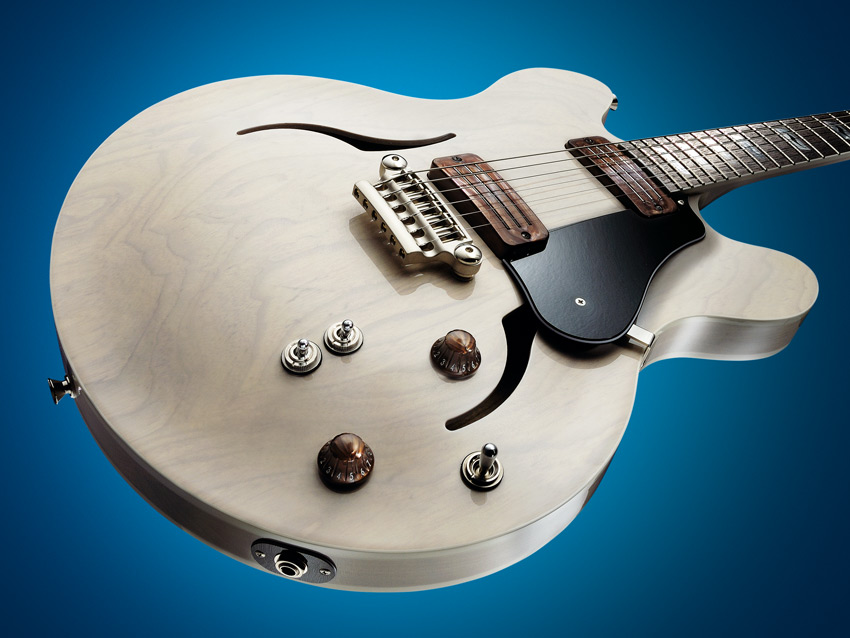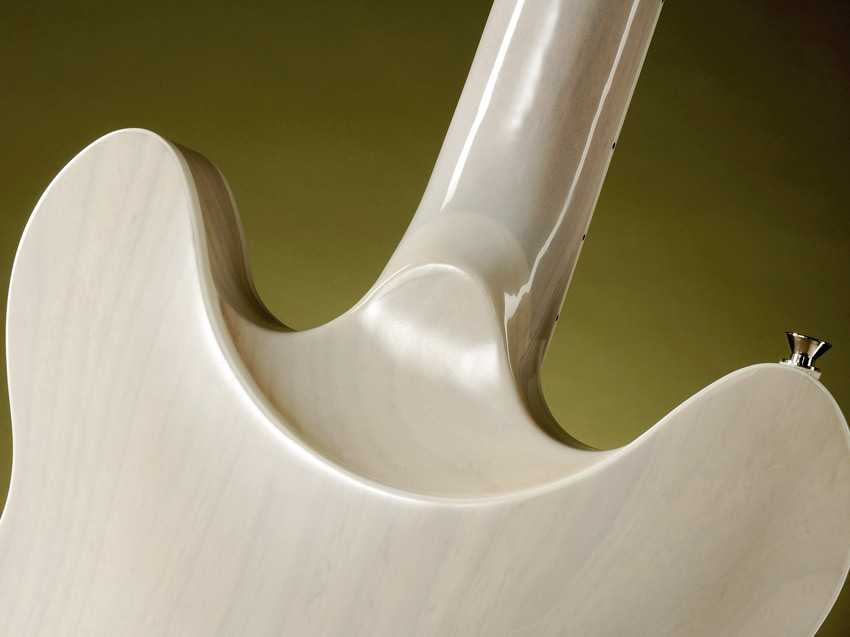MusicRadar Verdict
The Virage DC salutes the ES-335 by creating a fabulously carved solidwood design that, via unique pickups, is one of the most versatile electrics we´ve ever played.
Pros
- +
Stunning design. Light weight. Acoustic resonance. Wide range of classic sounds.
Cons
- -
Higher price than we’d expect. Control knobs/switches hard to tweak quickly.
MusicRadar's got your back

Vox Virage DV review

Vox Virage DV review
Despite the constant trend for all things retrograde, a few guitar companies actually want to push the design of the instrument forwards. You can now add Vox to that list.
It doesn't take an expert to see the blatant influence of this design: the Gibson ES-335 - one of the finest hybrid designs ever merging the archtop history of Gibson with its then new-fangled solidbody electric the Les Paul. But to dismiss the Virage DC as just another ES-335 clone is seriously missing the point.
Construction
The familiar symmetric ES-335-ish outline has been downsized by approximately 10 per cent, giving us a width of 368mm (14.5-inch) instead of 406mm (16-inch), and an overall body length of 446mm (17.5-inch) as opposed to 483mm (19-inch).
The Virage is all made of solid wood - not maple laminates. It's created by complex computer-controlled routing programs that actually carve two halves - top and bottom - inside (including a unique partial centre block) and outside.
Along with the deeply dished, violin-like top carve and more polite but still heavily dished back, the whole form is gently curved. Imagine having an ES-335 in playing position on your lap and being able to wrap it around your body.
The two halves are jointed seamlessly; you can just see the differing grain of the ash on the body sides through the semi-translucent 'ash blonde' acrylic gloss finish. Both halves seem to be two-piece, with off centre joins that really don't ruin the fun and are probably better from a structural viewpoint.
But this body geometry is fantastic: as futuristic as the Parker Fly but way easier on the eye. The build also results in a featherweight guitar that feels like it'll vibrate all by itself. The closest craft (outside of way more expensive hand-carving) has to be PRS's Hollowbody, but we have to say the curves here are more fluid.
Want all the hottest music and gear news, reviews, deals, features and more, direct to your inbox? Sign up here.
"The guitar truly holds its own in illustrious company and is simply stunning from design to execution."
The clever bit is combining such modernism with the essence of a 50-year-old shape, with classic features like the double white binding that's burnt into every guitarist's personal hard disk and filed under 'cool'.
The careful balance between old and new continues with what is a completely standard mahogany neck, a very comfortable full 'C' profile (approx 20.6mm at the first fret, 23.2 at the 12th) with bound rosewood 'board and three-a-side, quite retro-style headstock back-angled some 10.5 degrees: shallower than a Les Paul, more extreme than a PRS.
The heel is scooped away and the binding continues not around the heel but in a contrasting curve - unusual, but from a playing viewpoint it is perfect. The binding is very clean, likewise the fretting, which is approx 2.7mm wide x 1.05mm high: a nice old feeling medium jumbo wire.
The inlays are cleanly done too with the centre black 'wave' motif (echoed on the custom tuner buttons, the headstock logo and the double f-holes) contrasting the mother-of-pearl offset blocks. Even the headstock has a classicism to it that, with the large Vox silver logo, looks purposely backwards. It's a very considered, thoughtful design, and that's just the chassis!
Aside from the tweaked tuners, it's the cast aluminium bridge that's most profoundly custom designed. The anodised look is immediately classy and it's like a wrap-over bridge, in terms of its fixing to the bright nickel brass posts, but 'unfolded' so the strings anchor at the back extension rather than underneath the unit.
Overall height adjustment is easier than the Gibson standard via an Allen key hole, not a large slot, and like a tune-o-matic/stud tailpiece combination you can easily palm mute behind the saddles.
Electronics
The pickups too are complete redesigns: a concept thought up by one of the design team, Eric Kirkland, and put into practice by Steve Blucher at DiMarzio, where pickups are made exclusively for Vox.
Essentially it's three coils, each with its own blade polepiece. Via a large easy-to-move mode switch, each pickup has three sounds that Vox calls clean, crunch and lead, although you could view the intended 'characters' created by the mode switch as hot output humbucker, P-90, and single-coil if it helps to visualise the sonic intent.
If you number the coils 1, 2 and 3 (the #1 coil being closest to the bridge on the bridge pickup and closest to the fingerboard on the neck pickup), then we have coils #2 and #3 in series for the lead mode; coils #1 and #3 in series for the crunch mode and coils #2 and #3 in parallel for the clean mode (all are humbucking and noiseless).
The pickups mount directly to the body with just a little rubber cushion - unlike a standard humbucker, and more like a similarly-dimensioned P-90 soapbar- and there's minimal height adjustment.
The hook-up after these new pickups and their mode switches is straightforward - another metal-tipped three-way toggle switch selects either or both pickups, then we have master volume and tone.
Only the side-mounted output jack, on a sturdy plastic oval plate, seems a bit of an after thought - wouldn't a metal plate be more robust and in keeping with the design?
Sounds
Beginning with the bridge pickup, Guitarist Editor Mick Taylor runs through some of the Virage's sounds:
The DC, from the off, is characterised by resonance, versatility and above all quite a classic character. In many ways, of course, it's like having three guitars in one when you consider the three modes of each pickup but as soon as you start playing, thanks to the roomy and acoustically big sounding platform, many more spring to mind.
In basic terms the lead and crunch sounds are close in output, the crunch just a little wider and brighter sounding as opposed to the darker, more focused lead voice. The clean mode drops in volume, as you'd expect, but there's no hum. So far so good…
But clean single-coil-like sounds (Fender, as opposed to P-90s) on a virtual hollowbody? This is where the fun starts. On a solid platform you'd expect a more direct, brighter delivery; here there's a really toneful depth, and while the bridge pickup in this clean mode retains bite and clarity it's very useable.
The other extreme, let's say the neck pickup in lead mode with the tone rolled off, is a dark 'woman' tone; but kick in some gain and you create this soupy sustained voice that, by rolling a little of the tone back, becomes slightly clearer - a really emotive, Clapton-esque lead tone. It's quite a contrast, but one that illustrates the wide tonal range of this pickup system.
With both pickups on, the mixtures of the different characters create a very strong palette of textured tones, especially as you can combine similar or different pickup modes. From old style soul and funk to modern day, strummier, poppier, more gained rhythm sounds, there's a lot of scope here - especially if you use the volume and tone controls - producing sounds that evoke old-style Epiphone, Gibson, Gretsch and Rickenbacker semis.
The lead modes are a little narrower sounding compared to a classic-spec PAF-style humbucker, yet in the context of the guitar they work perfectly; they're not over powerful or too mid-range heavy and capture quite a classic humbucker voicing that, although it won't challenge a really good PAF-loaded ES-335, still sounds very musical and stylistically useful.
Likewise the crunch modes (which quickly became this writer's favourites) are edgier but not overly bright, powerful but nicely open and transparent. This mode switching is useful in a recording environment when tracking guitar parts. Switching from the lead to the crunch provides a subtle but noticeable change and would quickly, even through the same amp, enable you to build thick, textured overdubbed parts.
The original proposed retail price on these instruments was far lower that the eventual price quoted here, which has affected our expectations. It elevates the instruments into a price bracket where they compete with the world's best. No only that, with zero heritage in terms of this new design, it'll require quite a leap of faith over the likes of Gibson, PRS etc.
That said, the guitar truly holds its own in such illustrious company and is simply stunning from design to execution.
Dave Burrluck is one of the world’s most experienced guitar journalists, who started writing back in the '80s for International Musician and Recording World, co-founded The Guitar Magazine and has been the Gear Reviews Editor of Guitarist magazine for the past two decades. Along the way, Dave has been the sole author of The PRS Guitar Book and The Player's Guide to Guitar Maintenance as well as contributing to numerous other books on the electric guitar. Dave is an active gigging and recording musician and still finds time to make, repair and mod guitars, not least for Guitarist’s The Mod Squad.
